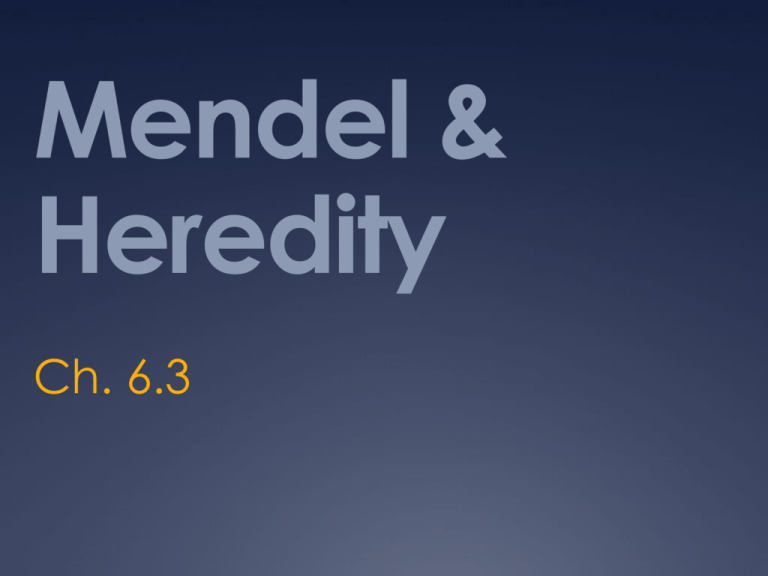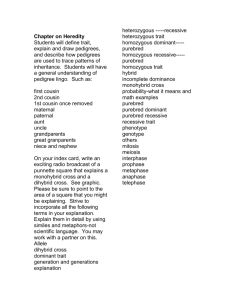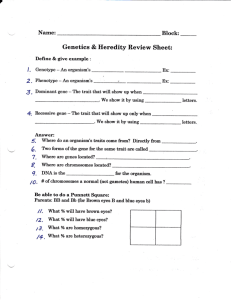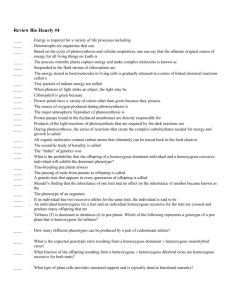B b
advertisement

Mendel & Heredity Ch. 6.3 Gregor Mendel Mid-1800’s he explained how traits are inherited from parents and passed to offspring Every organism inherits their specific traits (AKA genes) One from Mom and one from Dad Mendel made this discovery by breeding peas Mendel’s Pea Plant Experiments 1. Controlled the breeding 2. Used purebred plants 3. Observed “either-or” traits that appeared in only two alternate forms Why were these factors important for his experiment? Traits Observed How did Mendel discover dominant/recessive traits? Punnett Squares! http://www.siskiyous.edu/class/bio1/genetics/monohybrid_v2.html Mendel’s Conclusions 1.) Traits are inherited as discrete units 2.) Organisms inherit two copies of each gene, one from each parent 3.) Organisms donate only one copy of each gene in their gametes. Thus the two copies of each gene segregate, or separate, during gamete formation (#2 & 3 = Law of segregation) Traits Observed Vocabulary 1. Genetics 10. Homozygous 2. Gene 11. Heterozygous 3. Allele 12. Purebred 4. Law of Segregation 13. Dominant 5. Law of Independent Assortment 14. Recessive 6. Punnett Square 7. Probability 8. Monohybrid Cross 9. Dihybrid Cross 15. Phenotype 16. Genotype 17. Incomplete Dominance 18. Codominance 19. Polygenetic Inheritance 20. Sex-Linked Complex Patterns of Inheritance Ch. 7.2 Incomplete Dominance = where heterozygous phenotype is somewhere between two homozygous types. AKA= Blending of traits Ex: colors of certain flowers where: RR= red Rr= pink rr=white Neither allele is completely dominant or recessive! Codominance = where both alleles of a gene are expressed completely Both traits are fully and separately shown Ex: blood types where a person can have- A, B, AB, or O Blood Types We always use the letter “I” AND superscript to show blood genotypes IA and IB are codominant and i is recessive Blood Types So what does this mean for blood donations and transfusions? Blood Types So what does this mean for blood donations and transfusions? Antigens are proteins on the blood that prevent transfusions from foreign blood types A= can only get blood from IAIA or ii B= can only get blood from IB IB or ii AB= can donate to IAIA or IB IB or IA IB, but can only receive from IA IB or ii O= is a universal donor, but can only accept transfusions from ii Polygenetics = traits produced by two or more genes Ex: human skin color (produces a range or spectrum of colors) What’s another example? Epistasis Epistatic genes= can interfere with the expression of other genes Mice and other mammals have 5 genes to determine color (making them polygenetic) The 5th gene can overshadow all other genes Ex: Albinism Dihybrid crosses =crosses that look at inheritance of two different traits. Ex: peas that are yellow/green with smooth/wrinkled skin Exit Slip A man with homozygous type A blood and a woman with heterozygous type B blood want to know the probability of having a child with type AB blood. Draw a Punnett Square and write a percentage. Genetics Disorder Brochure Project Create a tri-fold brochure Needs to be creative and informative Research a genetic disorder ANSWER ALL QUESTIONS!! Include work cited/reference page List of Genetic Diseases Adrenoleukodytrophy Patau Syndrome Angleman Syndrome Duchenne Muscular Dystrophy Edwards Syndrome Fabry Disase Hemophilia A/B Huntington’s Disease Burkitt’s Lymphoma Jacobson Syndrome Rett Syndrome Cat Eye Syndrome Marfan Syndrome Sickle Cell Anemia Cri-du-chat (Cat’s Cry Syn.) Monsomy 9p (Alfi’s Smith-Magenis Mytonic Dystrophy Von Hippel-Lindau Albinism, oculocutaneous Alzheimer Disease, familial type 5 Cystic Fibrosis DiGeorge Syndrome Down’s syndrome Syndrome) Neurofibromatosis (Trisomy 13) PKU Prader-Willi Syndrome Rentinitis pigmentosa Syndrome Syndrome Wolf Hirschhorn Syndrome Human Genetics & Pedigrees Ch. 7.4 Genetic Disorders Only females can be carries of sex-linked genetic disorders Brainstorm WHY? Genetic Disorders Only females can be carries of sex-linked genetic disorders Brainstorm WHY? Genetic Disorders The likelihood of inheriting a sex-linked disorder depends both on the sex of the child and which parent carries the disorder-causing allele. Do you think a boy or girl is more likely to have a sex-linked disorder if the mother is a carrier? Genetic Disorders in History Queen Victoria of the British royal family was a carrier for a sex-linked disorder called hemophilia Hemophilia= lacks proteins that allows blood to clot. She passed this disease to her son, and he then passed it to his daughter who was a carrier. Because royal families tend to marry into other royal families, several other countries blood lines now had hemophilia “The Royal Disease” Pedigrees Pedigree= chart that can help trace the phenotypes and genotypes in a family Helps to determine whether people carry recessive alleles Males= squares Females= circles Shaded= affected/ shows the trait Half-shaded= carrier for the trait Pedigrees The disease can be carried on autosomes or sex chromosomes Autosomal= gives males & females 50% chance of inheritance Patterns of Inheritance 1. Autosomal Dominant The inheritance of one mutated copy of a gene results in trait / disease. These traits / disorders tend to occur in every generation of an affected family. Examples: Huntington disease, polydactyly 2. Autosomal Recessive The inheritance of two mutated copies of a gene results in disease. An individual that inherits a single copy of the mutated gene is known as a carrier. Both males and females can be carriers. Examples: cystic fibrosis, sickle-cell anemia, Tay-Sachs disease 3. Sex-Linked (X-Linked Recessive) The inheritance of a mutated gene on an X chromosome may result in disease. Only females can be carriers, therefore men are more frequently affected by these types of disease. Examples: colorblindness, hemophilia Harry is the son of Lily and James Potter. Lily Potter had two parents and a sister without any magical ability (muggles). Assuming magical ability is recessive, what are the genotypes of Harry Potter’s maternal grandparents? Construct a Punnett square to justify your answer. Describe Harry Potter’s genotype using genetics vocabulary. Harry Potter’s maternal grandparents are heterozygous, Mm: M m M MM Mm m Mm mm Harry Potter, like his mother Lily, is homozygous recessive for magical ability. Biotechnology Hypothesize what it is? Biotechnology Hypothesize what it is? Biotechnology= the use and application of living things and biological processes What are some examples? Biotechnology Hypothesize what it is? Biotechnology= the use and application of living things and biological processes What are some examples? Microorganisms used to make bread and cheese Liquid BandAid used to seal wounds and replicate skin Hybrid fruit trees to create new fruits (Grapple) Medical Biotechnology Work in pairs with your shoulder partner (the person next to you) 1 iPad per pair Job Roles: Reporter- researches information and relays information to recorder Recorder- writes down information on paper YOU & YOUR PARTNER WILL TURN IN ONE SHEET OF PAPER WITH ALL THE INFORMATION! Medical Biotechnology Activity For your example, answer the following: 1. What is it? 2. What can it be used for? 3. How is biotechnology used in your example/product? 4. What are the potential impacts to 5. a) The individual (aka YOU!) b) Society c) The environment Record your findings on paper to be turned in Cite your sources! You need at least two. Genetically Modified Foods How much genetically modified food accounts for your daily diet? Are genetically engineered foods safe? Genetically Modified Foods What concerns does the video clip address? http://www.youtube.com/watch?v=aMfSGt6rHo s&feature=youtu.be&safe=active Do the benefits outweigh the disadvantages? http://www.youtube.com/watch?v=4QFhD1E8G Es&feature=endscreen&safe=active Biotechnology in Medicine Going back to when you researched biotech. In medicine with your shoulder partner… Turn around to the partnership behind you and discuss: 1. 2. 3. 4. What is it? What can it be used for? How is biotechnology used in your example/product? What are the potential impacts to you, society, & environment Be prepared to discuss as a class! If the trait for brown eyes (B) is dominant over blue eyes (b), what would be the probability of a man who’s heterozygous for the trait and a woman who’s homozygous recessive for the trait having a child with blue eyes? If the trait for brown eyes (B) is dominant over blue eyes (b), what would be the probability of a man who’s heterozygous for the trait and a woman who’s homozygous recessive for the trait having a child with blue eyes? B b b Bb bb b Bb bb Colorblindness is a sex-linked trait caused by a recessive allele carried on the X chromosome (Xc). What are the possible phenotypes for the children of a colorblind father (XcY) and normal vision mother (XCXC)? Colorblindness is a sex-linked trait caused by a recessive allele carried on the X chromosome (Xc). What are the possible phenotypes for the children of a colorblind father (XcY) and normal vision mother (XCXC)? Xc XC XC Y XCXc XCY XCXc XCY The probability that two parents who are heterozygous will have a child with a disorder is 25%. Which of the following best applies to the inheritance pattern for this disorder? The probability that two parents who are heterozygous will have a child with a disorder is 25%. Which of the following best applies to the inheritance pattern for this disorder? RECESSIVE List an example of a polygenetic trait in humans List an example of a polygenetic trait in humans Hair color, eye color, height, etc… A man with homozygous type A blood and a woman with heterozygous type B blood want to know the probability of having a child with type AB blood. A man with homozygous type A blood and a woman with heterozygous type B blood want to know the probability of having a child with type AB blood. B O A A AB AB AO AO What kind of genotype would the parents have to be to give you a 9:3:3:1 ratio? What kind of genotype would the parents have to be to give you a 9:3:3:1 ratio? 2 heterozygous parents Green seeds (G) are dominant over yellow seeds (g). What would the genotypes of a cross between a homozygous dominant and homozygous recessive plant? Green seeds (G) are dominant over yellow seeds (g). What would the genotypes of a cross between a homozygous dominant and homozygous recessive plant? G g g G Gg Gg Gg Gg If flower color has incomplete dominance, where RR=red, RW=pink, and WW=white, what would the results of a RW and RW cross? If flower color has incomplete dominance, where RR=red, RW=pink, and WW=white, what would the results of a RW and RW cross? R W R RR RW W RW WW Hemophilia is a sex-linked genetic disease. If a man with hemophilia and a woman who is a carrier had children, what is the probability that their son will have hemophilia? Hemophilia is a sex-linked genetic disease. If a man with hemophilia and a woman who is a carrier had children, what is the probability that their son will have hemophilia? XH Xh Xh XHXh XhXh Y XHY XhY Who is the father of genetics? Who is the father of genetics? Gregor Mendel What term would best be used to describe an organism possessing two identical genes for a trait? What term would best be used to describe an organism possessing two identical genes for a trait? HOMOZYGOUS In canaries, the gene for singing (S) is dominant over the gene for non-singing (s). When hybrid singing canaries are mated with non-singing canaries, what percentage of the offspring is likely to possess the singing trait? In canaries, the gene for singing (S) is dominant over the gene for non-singing (s). When hybrid singing canaries are mated with non-singing canaries, what percentage of the offspring is likely to possess the singing trait? S S s s SS Ss Ss Ss









